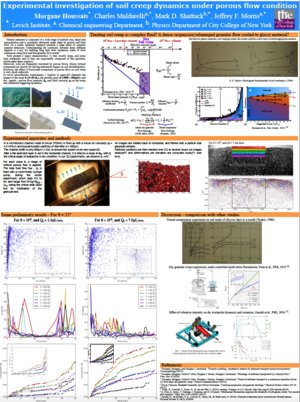Annualmeeting:2017 CSDMS meeting-115
Browse abstracts
Experimental investigation of soil creep under porous flow condition
[[CSDMS meeting abstract::Sediment transport modeling is challenging in all systems and flow regimes. Rivers, soils, and sea margins share a common feature: as their boundaries are mobile and constantly adapting, they tend to always be near the threshold of entrainment.
This difficulty becomes dramatic for steep soils, only doing very slow granular creep, but whose ultimately, under statistically rare conditions, can turn into a landslide, a very fast avalanche flow [Houssais and Jerolmack, 2017]. The abrupt transition from soil creep to avalanching remains mostly non-understood. Yet, capturing its dynamics -- being able to predict a regional statistics for landslide depending on topographic, tectonic and climatic conditions -- would allow for much more accurate landscape evolution modeling. We present here preliminary results of an experimental investigation of one the major triggering condition for soils destabilization: rain infiltration, and more generally porous flow through a tilted granular bed. In a quasi-2D microfluidics channel, a flat sediment bed made of spherical particles is prepared, in fully submerged condition. It is thereafter tilted (at slope under critical slope of avalanching) and simultaneously put under vertical weak porous flow (well under the critical flow of liquefaction regarding positive pressure gradients). The 2 control parameters are varied, and local particles concentration and motion are measured. Interestingly, although staying in the sub-critical creeping regime, we observe an acceleration of the bed deformation downward, as the porous flow and the bed slope are increased, until the criteria for avalanching is reached. Those results appear to present similitudes with the case of tilted dry sediment bed under controlled vibrations. Consequently it opens the discussion about a potential universal model of landslides triggering due to frequent seismological and rainstorm events.]]

